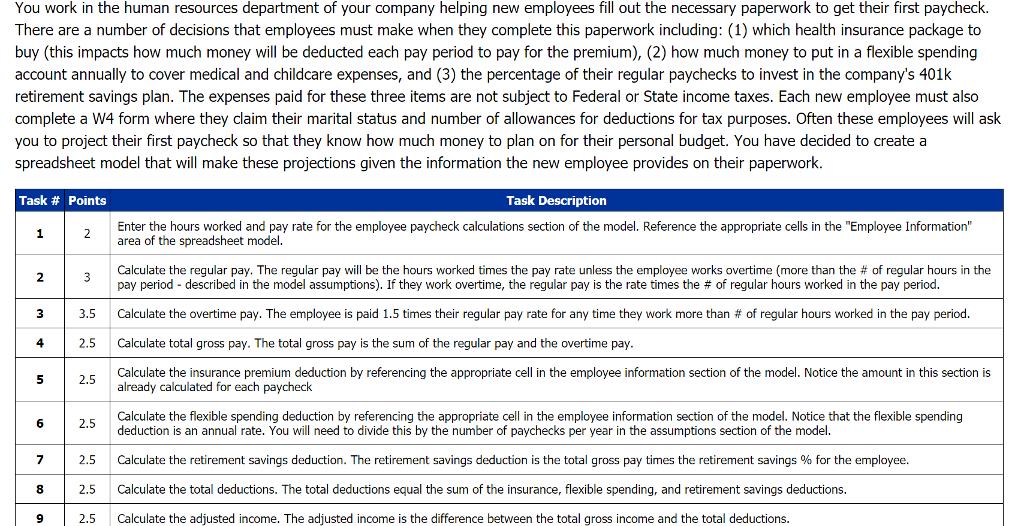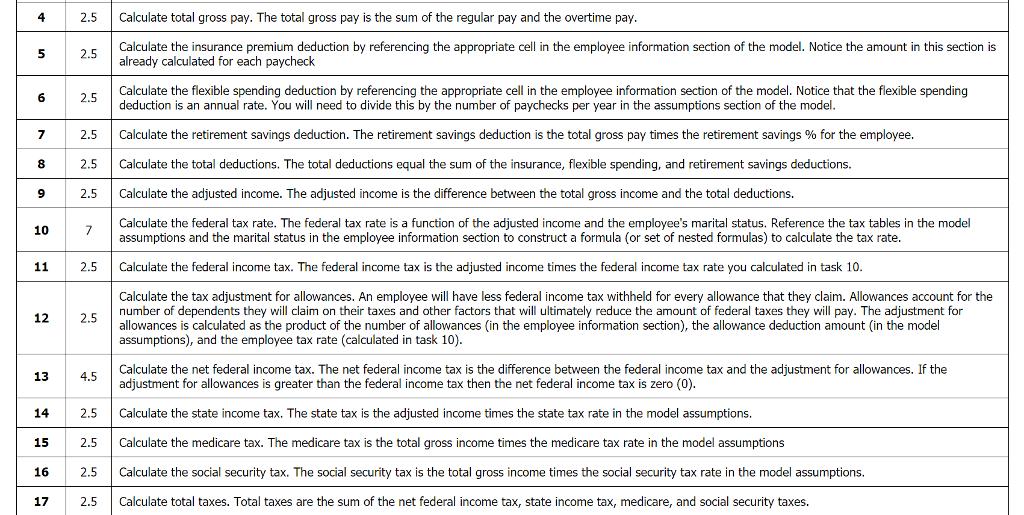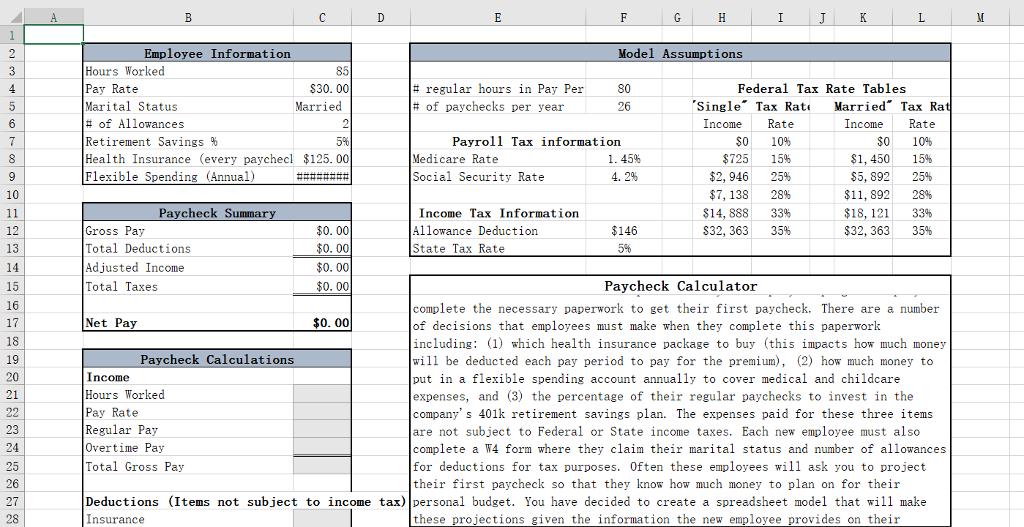You work in the human resources department of your company helping new employees fill out the...
Fantastic news! We've Found the answer you've been seeking!
Question:




Transcribed Image Text:
You work in the human resources department of your company helping new employees fill out the necessary paperwork to get their first paycheck. There are a number of decisions that employees must make when they complete this paperwork including: (1) which health insurance package to buy (this impacts how much money will be deducted each pay period to pay for the premium), (2) how much money to put in a flexible spending account annually to cover medical and childcare expenses, and (3) the percentage of their regular paychecks to invest in the company's 401k retirement savings plan. The expenses paid for these three items are not subject to Federal or State income taxes. Each new employee must also complete a W4 form where they claim their marital status and number of allowances for deductions for tax purposes. Often these employees will ask you to project their first paycheck so that they know how much money to plan on for their personal budget. You have decided to create a spreadsheet model that will make these projections given the information the new employee provides on their paperwork. Task # Points Task Description Enter the hours worked and pay rate for the employee paycheck calculations section of the model. Reference the appropriate cells in the "Employee Information" area of the spreadsheet model. 1 2 Calculate the regular pay. The regular pay will be the hours worked times the pay rate unless the employee works overtime (more than the # of regular hours in the 3 pay period - described in the model assumptions). If they work overtime, the reqular pay is the rate times the # of regular hours worked in the pay period. 3 3.5 Calculate the overtime pay. The employee is paid 1.5 times their reqular pay rate for any time they work more than # of reqular hours worked in the pay period. 4 2.5 Calculate total gross pay. The total gross pay is the sum of the regular pay and the overtime pay. Calculate the insurance premium deduction by referencing the appropriate cell in the employee information section of the model. Notice the amount in this section is already calculated for each paycheck 5 2.5 Calculate the flexible spending deduction by referencing the appropriate cell in the employee information section of the model. Notice that the flexible spending deduction is an annual rate. You will need to divide this by the number of paychecks per year in the assumptions section of the model. 6 2.5 2.5 Calculate the retirement savings deduction. The retirement savings deduction is the total gross pay times the retirement savings % for the employee. 8 2.5 Calculate the total deductions. The total deductions equal the sum of the insurance, flexible spending, and retirement savings deductions. 9 2.5 Calculate the adjusted income. The adjusted income is the difference between the total gross income and the total deductions. 4 2.5 Calculate total gross pay. The total gross pay is the sum of the regular pay and the overtime pay. Calculate the insurance premium deduction by referencing the appropriate cell in the employee information section of the model. Notice the amount in this section is already calculated for each paycheck 5 2.5 Calculate the flexible spending deduction by referencing the appropriate cell in the employee information section of the model. Notice that the flexible spending deduction is an annual rate. You will need to divide this by the number of paychecks per year in the assumptions section of the model. 2.5 7 2.5 Calculate the retirement savings deduction. The retirement savings deduction is the total gross pay times the retirement savings % for the employee. 8 2.5 Calculate the total deductions. The total deductions equal the sum of the insurance, flexible spending, and retirement savings deductions. 2.5 Calculate the adjusted income. The adjusted income is the difference between the total gross income and the total deductions. Calculate the federal tax rate. The federal tax rate is a function of the adjusted income and the employee's marital status. Reference the tax tables in the model assumptions and the marital status in the employee information section to construct a formula (or set of nested formulas) to calculate the tax rate. 10 7 11 2.5 Calculate the federal income tax. The federal income tax is the adjusted income times the federal income tax rate you calculated in task 10. Calculate the tax adjustment for allowances. An employee will have less federal income tax withheld for every allowance that they claim. Allowances account for the number of dependents they will claim on their taxes and other factors that will ultimately reduce the amount of federal taxes they will pay. The adjustment for allowances is calculated as the product of the number of allowances (in the employee information section), the allowance deduction amount (in the model assumptions), and the employee tax rate (calculated in task 10). 12 2.5 Calculate the net federal income tax. The net federal income tax is the difference between the federal income tax and the adjustment for allowances. If the adjustment for allowances is greater than the federal income tax then the net federal income tax is zero (0). 13 4.5 14 2.5 Calculate the state income tax. The state tax is the adjusted income times the state tax rate in the model assumptions. 15 2.5 Calculate the medicare tax. The medicare tax is the total gross income times the medicare tax rate in the model assumptions 16 2.5 Calculate the social security tax. The social security tax is the total gross income times the social security tax rate in the model assumptions. 17 2.5 Calculate total taxes. Total taxes are the sum of the net federal income tax, state income tax, medicare, and social security taxes. B E F G H I J K M 2 Employee Information Model Assumptions Hours Worked Pay Rate Marital Status # of Allowances Retirement Savings % Health Insurance (every paychecl $125. 00 Flexible Spending (Annual) 85 $30. 00 # regular hours in Pay Per # of paychecks per year 4 80 Federal Tax Rate Tables 5 Married 26 "Single" Tax Rate Married" Tax Rat 2 Income Rate Income Rate $0 $0 $1, 450 $5, 892 $11, 892 7 5% Payroll Tax information 10% 10% Medicare Rate Social Security Rate 8 1. 45% $725 15% 15% $2, 946 $7, 138 9 #### 4. 2% 25% 25% 10 28% 28% 11 Paycheck Summary Income Tax Information $14, 888 33% $18, 121 33% Gross Pay Total Deductions Ad justed Income Total Taxes $0. 00 $0. 00 12 Allowance Deduction $146 $32, 363 35% $32, 363 35% 13 State Tax Rate 5% $0. 00 $0. 00 14 15 Paycheck Calculator 16 complete the necessary paperwork to get their first paycheck. There are a number of decisions that employees must make when they complete this paperwork including: (1) which health insurance package to buy (this impacts how much money will be deducted each pay period to pay for the premium), (2) how much money to put in a flexible spending account annually to cover medical and childcare expenses, and (3) the percentage of their regular paychecks to invest in the company's 401k retirement savings plan. The expenses paid for these three items are not subject to Federal or State income taxes. Each new employee must also complete a W4 form where they claim their marital status and number of allowances for deductions for tax purposes. Often these employees will ask you to project their first paycheck so that they know how much money to plan on for their 17 Net Pay $0. 00 18 19 Paycheck Calculations 20 Income 21 Hours Worked Pay Rate Regular Pay 22 23 Overtime Pay Total Gross Pay 24 25 26 27 Deductions (Items not subject to income tax) personal budget. You have decided to create a spreadsheet model that will make 28 Insurance these projections given the information the new employee provides on their Deductions (Items not subject to income tax) personal budget. You have decided to create a spreadsheet model that will make these projections given the information the new employee provides on their 27 28 Insurance Flexible Spending Retirement 29 Total Deductions Adjusted Income 34 |Тахes Federal Income Tax Rate Federal Income Tax Adjustment for Allowances Net Federal Income Tax State Income Tax Medicare Tax Social Security Tax 35 36 37 39 39 40 41 42 43 Total Taxes You work in the human resources department of your company helping new employees fill out the necessary paperwork to get their first paycheck. There are a number of decisions that employees must make when they complete this paperwork including: (1) which health insurance package to buy (this impacts how much money will be deducted each pay period to pay for the premium), (2) how much money to put in a flexible spending account annually to cover medical and childcare expenses, and (3) the percentage of their regular paychecks to invest in the company's 401k retirement savings plan. The expenses paid for these three items are not subject to Federal or State income taxes. Each new employee must also complete a W4 form where they claim their marital status and number of allowances for deductions for tax purposes. Often these employees will ask you to project their first paycheck so that they know how much money to plan on for their personal budget. You have decided to create a spreadsheet model that will make these projections given the information the new employee provides on their paperwork. Task # Points Task Description Enter the hours worked and pay rate for the employee paycheck calculations section of the model. Reference the appropriate cells in the "Employee Information" area of the spreadsheet model. 1 2 Calculate the regular pay. The regular pay will be the hours worked times the pay rate unless the employee works overtime (more than the # of regular hours in the 3 pay period - described in the model assumptions). If they work overtime, the reqular pay is the rate times the # of regular hours worked in the pay period. 3 3.5 Calculate the overtime pay. The employee is paid 1.5 times their reqular pay rate for any time they work more than # of reqular hours worked in the pay period. 4 2.5 Calculate total gross pay. The total gross pay is the sum of the regular pay and the overtime pay. Calculate the insurance premium deduction by referencing the appropriate cell in the employee information section of the model. Notice the amount in this section is already calculated for each paycheck 5 2.5 Calculate the flexible spending deduction by referencing the appropriate cell in the employee information section of the model. Notice that the flexible spending deduction is an annual rate. You will need to divide this by the number of paychecks per year in the assumptions section of the model. 6 2.5 2.5 Calculate the retirement savings deduction. The retirement savings deduction is the total gross pay times the retirement savings % for the employee. 8 2.5 Calculate the total deductions. The total deductions equal the sum of the insurance, flexible spending, and retirement savings deductions. 9 2.5 Calculate the adjusted income. The adjusted income is the difference between the total gross income and the total deductions. 4 2.5 Calculate total gross pay. The total gross pay is the sum of the regular pay and the overtime pay. Calculate the insurance premium deduction by referencing the appropriate cell in the employee information section of the model. Notice the amount in this section is already calculated for each paycheck 5 2.5 Calculate the flexible spending deduction by referencing the appropriate cell in the employee information section of the model. Notice that the flexible spending deduction is an annual rate. You will need to divide this by the number of paychecks per year in the assumptions section of the model. 2.5 7 2.5 Calculate the retirement savings deduction. The retirement savings deduction is the total gross pay times the retirement savings % for the employee. 8 2.5 Calculate the total deductions. The total deductions equal the sum of the insurance, flexible spending, and retirement savings deductions. 2.5 Calculate the adjusted income. The adjusted income is the difference between the total gross income and the total deductions. Calculate the federal tax rate. The federal tax rate is a function of the adjusted income and the employee's marital status. Reference the tax tables in the model assumptions and the marital status in the employee information section to construct a formula (or set of nested formulas) to calculate the tax rate. 10 7 11 2.5 Calculate the federal income tax. The federal income tax is the adjusted income times the federal income tax rate you calculated in task 10. Calculate the tax adjustment for allowances. An employee will have less federal income tax withheld for every allowance that they claim. Allowances account for the number of dependents they will claim on their taxes and other factors that will ultimately reduce the amount of federal taxes they will pay. The adjustment for allowances is calculated as the product of the number of allowances (in the employee information section), the allowance deduction amount (in the model assumptions), and the employee tax rate (calculated in task 10). 12 2.5 Calculate the net federal income tax. The net federal income tax is the difference between the federal income tax and the adjustment for allowances. If the adjustment for allowances is greater than the federal income tax then the net federal income tax is zero (0). 13 4.5 14 2.5 Calculate the state income tax. The state tax is the adjusted income times the state tax rate in the model assumptions. 15 2.5 Calculate the medicare tax. The medicare tax is the total gross income times the medicare tax rate in the model assumptions 16 2.5 Calculate the social security tax. The social security tax is the total gross income times the social security tax rate in the model assumptions. 17 2.5 Calculate total taxes. Total taxes are the sum of the net federal income tax, state income tax, medicare, and social security taxes. B E F G H I J K M 2 Employee Information Model Assumptions Hours Worked Pay Rate Marital Status # of Allowances Retirement Savings % Health Insurance (every paychecl $125. 00 Flexible Spending (Annual) 85 $30. 00 # regular hours in Pay Per # of paychecks per year 4 80 Federal Tax Rate Tables 5 Married 26 "Single" Tax Rate Married" Tax Rat 2 Income Rate Income Rate $0 $0 $1, 450 $5, 892 $11, 892 7 5% Payroll Tax information 10% 10% Medicare Rate Social Security Rate 8 1. 45% $725 15% 15% $2, 946 $7, 138 9 #### 4. 2% 25% 25% 10 28% 28% 11 Paycheck Summary Income Tax Information $14, 888 33% $18, 121 33% Gross Pay Total Deductions Ad justed Income Total Taxes $0. 00 $0. 00 12 Allowance Deduction $146 $32, 363 35% $32, 363 35% 13 State Tax Rate 5% $0. 00 $0. 00 14 15 Paycheck Calculator 16 complete the necessary paperwork to get their first paycheck. There are a number of decisions that employees must make when they complete this paperwork including: (1) which health insurance package to buy (this impacts how much money will be deducted each pay period to pay for the premium), (2) how much money to put in a flexible spending account annually to cover medical and childcare expenses, and (3) the percentage of their regular paychecks to invest in the company's 401k retirement savings plan. The expenses paid for these three items are not subject to Federal or State income taxes. Each new employee must also complete a W4 form where they claim their marital status and number of allowances for deductions for tax purposes. Often these employees will ask you to project their first paycheck so that they know how much money to plan on for their 17 Net Pay $0. 00 18 19 Paycheck Calculations 20 Income 21 Hours Worked Pay Rate Regular Pay 22 23 Overtime Pay Total Gross Pay 24 25 26 27 Deductions (Items not subject to income tax) personal budget. You have decided to create a spreadsheet model that will make 28 Insurance these projections given the information the new employee provides on their Deductions (Items not subject to income tax) personal budget. You have decided to create a spreadsheet model that will make these projections given the information the new employee provides on their 27 28 Insurance Flexible Spending Retirement 29 Total Deductions Adjusted Income 34 |Тахes Federal Income Tax Rate Federal Income Tax Adjustment for Allowances Net Federal Income Tax State Income Tax Medicare Tax Social Security Tax 35 36 37 39 39 40 41 42 43 Total Taxes
Expert Answer:
Answer rating: 100% (QA)
Paycheck Calculations Regular Pay at cell C23 F4C4 Overtime Pay at cell C24 Max0C... View the full answer

Related Book For 

Fundamentals of Human Resource Management
ISBN: 978-0077718367
6th edition
Authors: Raymond Noe, John Hollenbeck, Barry Gerhart, Patrick Wright
Posted Date:
Students also viewed these human resource management questions
-
You work in the human resources department of a busy downtown hospital. Parking is always a problem. Hospital employees have a few parking lots available to them, but the cost can be as much as $14 a...
-
Imagine you work in the human resources department of a company considering a policy to protect its data on employees' mobile devices. In advising on this policy, what rights should be considered?
-
A specialist in the Human Resources department of a national hotel chain is looking for ways to improve retention among hotel staff. The problem is particularly acute among those who maintain rooms,...
-
Suppose the given numbers for a mental calculation (see Problem 59) are 10x + y and 10x + z. Notice that these two numbers have the same tens digit. Also assume that y + z = 10, which says that the...
-
What do you think the effect would be if Congress changes the law so that retirement plan contributions are included in taxable income at the time they are made rather than taxing the payment when...
-
Determine the phase and the specific volume for ammonia at these states using the Appendix B table. a. 10oC, 150 kPa b. 20oC, 100 kPa c. 60oC, quality 25%
-
The Anchor Glass Container Corporation and its parent company, Consumers Packaging, Inc. (CPI), entered into a series of agreements with Encore Glass, Inc., to supply glass containers of a specific...
-
DeWitt Company uses flexible budgets to control its selling expenses. Monthly sales are expected to range from $170,000 to $200,000. Variable costs and their percentage relationship to sales are:...
-
The threshold frequency v0 describes the smallest light frequency capable of ejecting electrons from a metal. Determine the minimum energy E0 of a photon capable of ejecting electrons from a metal...
-
The Dover Direct Insurance Agency began operations on June 1, 2018. In the month of June, the following transactions occurred: June 2: Dover Direct's owner invested $80,000 (the par value of the...
-
In El Yunque in Puerto Rico, 116 male frogs were studied. Biologistic found that the call duration of the coquis is linearly related to their altitude in the rainforest. When the coquis call for 350...
-
Explain how the basis rules work to defer rather than exclude a partner's recognition of gain associated with a partnership distribution.
-
Will an acquiring corporation recognize gain or loss when it issues its stock to acquire the assets or stock of a target corporation in a reorganization?
-
Which transfers of life insurance policies prior to death are includible in the transferor's gross estate?
-
In a rental agreement, when are improvements to the property made by the lessee regarded as income?
-
What distinguishes a direct rollover from an indirect rollover?
-
Briefly summarise these set of data (1000 characters) Industry Trends Report 30th June 2020: A new report published today highlights the latest trends in the UK Telecoms sector. A summary of the key...
-
Nike manufactures shoes and sportswear. How has the Internet changed the way this company communicates with its suppliers and retail customers?
-
What pros and cons of downsizing do you think apply to this example?
-
What challenges do current college graduates face?
-
How might fast-food companies and their franchisees approach the minimum-wage issue through union-management collaboration? Would you recommend this approach? Why or why not?
-
Study the density matrix and the partition function of a system of free particles, using the unsymmetrized wavefunction (5.4.3) instead of the symmetrized wavefunction (5.5.7). Show that, following...
-
Show that in the first approximation the partition function of a system of \(N\) noninteracting, indistinguishable particles is given by \[ Q_{N}(V, T)=\frac{1}{N ! \lambda^{3 N}} Z_{N}(V, T), \]...
-
Show that, for any law of distribution of molecular speeds, \[ \left\{\langle uangle\left\langle\frac{1}{u}ightangleight\} \geq 1 \] Check that the value of this quantity for the Maxwellian...

Study smarter with the SolutionInn App


